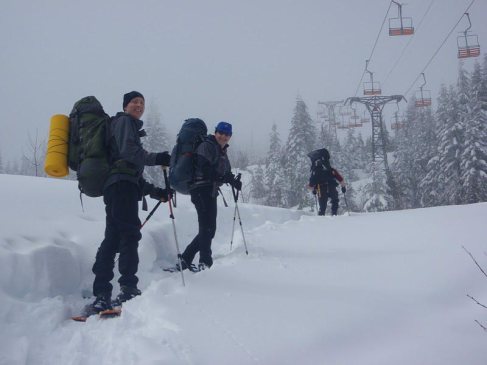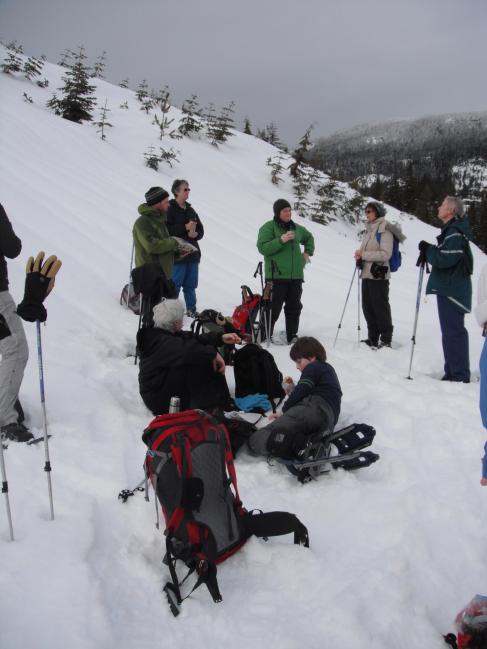If you have never been winter camping then you are missing out on a fun adventure. Winter camping can be a magical experience of huge star filled skies and bright moonlight nights. However to really enjoy winter camping it is important to be prepared for the significant differences between winter and summer camping. One of the biggest differences is the length of the night. In the summer you might only get 6 hours of darkness whereas in winter you could easily have 14 hours of darkness, if not more.
Mode of travel.
Travelling in winter will involve extra equipment to compensate for the snow on the ground. Typical equipment would be snowshoes, backcountry XC skis or backcountry skis. Whichever you are using it’s a good idea to have a suitable repair kit should you have any problems with the equipment as it can take a long time to walk out through deep snow.
Extra equipment
As well as skis or snowshoes to travel with you are going to need some additional equipment for winter camping. One very important item is a good snow shovel, perfect for digging out snow caves, tent platforms, cooking shelters. If you are travelling in avalanche terrain make sure you have been trained in avalanche awareness and have the required safety equipment and know how to use it. You will need a winter sleeping bag. A general rule of thumb is use one that is rated 10 degrees below the minimum temperatures that you are expecting.
Keeping warm and dry.
Layering is of the utmost importance in winter activities. The mantra of winter travel is stay dry at all costs. In winter having wet or damp layers will cause you to lose heat very rapidly. So follow the advice in last month’s article on winter clothing to make sure that you will stay comfortable in winter environments. Adjust layers as necessary to prevent sweating. Why not just have lots of layers on and sweat? Heat loss from a wet surface can be up to 25 times greater than a dry surface (due to the higher density of water). If you sweat and get soaked, you will lose heat much more quickly through evaporation of the water. Also you are losing an incredible amount of water through sweating since the air is so dry. Too much water loss leads to dehydration which significantly increases the risk of hypothermia. So you want to control your layers so as to be warm at the activity level you are in but not sweating profusely.
As you go through the day you will be adding and shedding layers frequently, much more so than in summer.
- When you first get up in the morning (and at the end of the day in camp), your activity level will be low as will be the temperature. You will need to have many, if not all, of your layers on at this point until breakfast is over and you have started to become active.
- When you get ready to be active, you will need to take off layers since you will begin generating heat. A good rule of thumb is to strip down until you feel just cool, not chilled just before activity. Failure to do this will mean overheating, sweating, losing heat and you will have to stop in 10 minutes down the trail anyway to take layers off. Open or closing zippers, rolling sleeves up or down, taking a hat off or putting one on will all help with temperature regulation.
- If you stop for more than a few minutes, you will need to put on another layer to keep from getting chilled. Keep a layer close at hand.
- Whenever you get covered with snow, either from a fall or from dislodged snow from a tree, it is essential to brush yourself off to keep your clothing free of snow. Failure to do this often results in the snow melting into your clothing and refreezing as ice.
- At the end of the day, as activity decreases and temperature drops, you will need to add layers. Once you start to cool down it takes a lot of the body’s resources (calories) to heat up again so layer up ASAP before you get chilled. It may be good to put on more than you think you need; it will only get colder. If you are too warm, you can open up layers and ventilate to reach the proper temperature.
A good heavyweight down jacket is perfect for this evening layer. It is great to put on while you are sitting and cooking and eating supper.
Setting up camp.
Think about where you will camp to avoid low lying areas where cold air tends to sink and collect such as valley bottoms, lake margins. These will also be darker and cooler in the morning as the suns warmth will hit the hilltops and sides before reaching into the valleys.
If you have access to a 4 season tent then this will be ideal but if not then it is possible to camp in winter in your 3 season tent. 4 season tents are generally sturdier, withstand wind and snowloading better and have much less mesh to improve warmth inside them. They are also generally heavier. My 3 person 3 season tent weighs under 5lbs but my 4 season 2 person tent weighs nearly 7lbs. To prevent cold draughts if using a mesh lined tent pack snow around the edges of the tent. Your tent wants to be a freestanding model requiring minimal pegging as it it is hard to use regular tent pegs in snow. I use my skis as pegs, 4 skis are enough to hold the tent upright.
When you first get into camp, leave your snowshoes or skis on and begin to tramp down areas for tents and your kitchen. If possible, let the snow set up for 30 minutes or so, this will minimize postholing once you take snowshoes or skis off. Set up your tents with the doors at 90 degrees to the prevailing winds. Stake the tents out. On a cold night you can build snow walls on the windward side of the tent. Mound the sides of the tent with snow (have someone inside pushing out on the tent to keep it from collapsing). When the snow sets up you will have a hybrid tent-snow shelter which will have better insulation than the tent alone. Dig out a pit in front of your tent for a porch. This makes taking your boots off much easier. Put your foam pads in the tent and unstuff your sleeping bag and place it in the tent so it can “expand” from it’s stuffed size.
Some people prefer to travel lighter and dig a snowpit or snow cave to sleep in, if this is going to be the case make sure that you leave plenty of time for its construction and that you have practised beforehand so that you can quickly and efficiently make your shelter. There is lots of information in books and online to show you how to create a range of different snow shelters. Make sure that you don’t build up too much of a sweat when digging out the snow and get chilled afterwards and always ensure that your shelter has adequate ventilation.
If the snow is deep, you may want to dig out a pit for your kitchen. Dig a pit at least 6 feet in diameter (for 4-6 people). You can mark out the circle using a ski or a rope. Dig down about 2-3 feet and pile the excavated snow around the perimeter. Pack the snow at the perimeter of the hole with your shovel. This will give you a 4-5 foot deep area, protected from the wind. You can carve out seats and benches, put your skis or snow shoes behind the pile as backrests, carve places for stoves, etc.
Cooking and food.
Planning food for winter activities must take into account the great demands the cold weather and physical activity places on the body along with the difficulty of preparing foods in the winter (it takes time, stove fuel) and having a menu which appeals to the group. Appetite is generally reduced during winter activity even through the food needs of the body have increased. If the meal isn’t appealing, it won’t get eaten. In some situations you literally need to force yourself to eat.
A liquid fuel stove generally works better in the winter as they burn hotter, boil water faster and cope better with colder temperatures than propane/butane cylinder stoves. However the cylinder stoves have got much better in recent years and now offer reasonable performance in winter conditions. Make sure your stove is in good working order, if necessary give it a service at the end of the summer, as having a malfunctioning stove on a winter camping trip is no fun. Use a windshield to reflect heat back into the pot so as to speed up cooking time and I like to use a base plate under my stove to prevent it sinking into the snow and tipping over.
I prefer to use the dehydrated packet meals as preparation is minimal and all I need to do is boil water and add it to the package. Once I have added the water it has to be left for 10-15mins before it is ready to eat. This is where these packet meals really shine as I can pop it into the inside pocket of my down jacket where it will act as a giant bodywarmer until the food is ready.
Drinking water
It is really important to maintain hydration levels during winter exercise and fortunately water is easy to find as it will be lying all around in the form of snow. Clean, fresh snow can be melted and doesn’t require any treatment. If you are worried about the snow then it is probably best to boil it for a few minutes to treat it. If you are extracting water from lakes or unfrozen streams bear in mind that chemical treatments may not be as effective at cold temperatures and may take significantly longer to work. Using pumps and filters is not recommended as any residual water may then freeze and the expansion of the ice formed may damage or crack the pump workings. I prefer to use wider mouthed Nalgene style bottles in the winter rather than a bladder as the small amount of water in the tubing of a bladder can easily freeze. The Nalgene style bottles make great body and sleeping bag warmers when filled with warm water.
General night sequence –
After dinner, getting warm water for water bottles, and putting gear away, it’s time for bed. This is a general sequence:
- Get warm before you get into your bag. Do some jumping jacks, etc. so your heat is built up for when you get in your bag.
- Get any clothing/gear you will need out of your pack as well as full water bottles and tomorrow’s lunch.
- At the tent door, brush off any snow on your clothing . Sit down inside the tent entrance and, keeping your boots outside, either have a friend brush them off, or remove them and brush them yourself.
- Climb into the tent and close the door.
- Strip off your layers of clothing to what will be appropriate in your sleeping bag. The more layers you wear the better insulated and the warmer you will be (contrary to the myth that says sleep in your underwear). However, too much clothing can compress dead air space in the bag and reduce its effectiveness.
- Remove any wet/damp layers and replace them with dry ones, particularly socks. Dry socks can make all the difference to feeling warm in your sleeping bag.
- Pre-warm your bag with your body (get it nice and toasty).
- Place damp items in the sleeping bag with you near your trunk. This will help dry them overnight.
- Place your boots in your sleeping bag stuff sack (turned inside out) and place the stuff sack between your legs. This will keep them from freezing during the night and the stuff sack keeps your legs from getting wet. Or remove the liners from your boots and bring them into your bag and leave the outers in the tent.
- Put water bottles and food with you in the bag.
- A hat will help keep you warm.
- Try to sleep with your face out of the bag. This reduces moisture build-up inside the bag (which could be catastrophic for a down bag). A scarf on your neck may be better than using the sleeping bag neck drawcord (which makes some people feel a little claustrophobic and creates a difficult nights sleep).
- You will probably wake up a number of times during the night. This is normal in cold weather. Your body needs to change position to allow for circulation to compressed tissues and to move around a bit so that muscle movement generates more heat. If you are still cold, eat some protein to “stoke up your furnace” If that doesn’t work, wake a tent-mate for some extra warmth.
- With 10 or more hours in the tent, you are likely to need to urinate in the middle of the night. Go for it! Otherwise you won’t get back to sleep, and your body is wasting energy keep all that extra fluid warm. You will be surprised how quickly you can get out and back in and your body really won’t chill that much. If you really don’t want to get out of the warmth have an old Nalgene bottle, suitably labelled!, as a pee bottle, just be careful not to miss!
- It is useful to have a thermos of hot drink in each tent.
- Make sure the tent has adequate ventilation to ensure that you don’t get too much moisture build up in the night.







 VS
VS 

